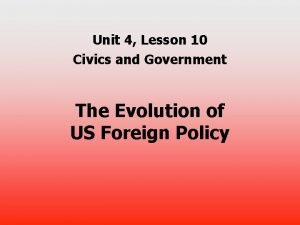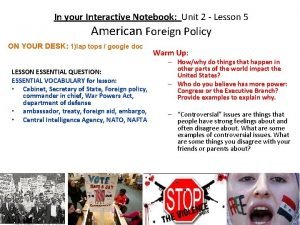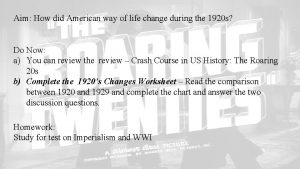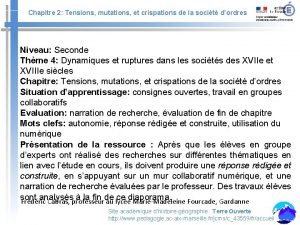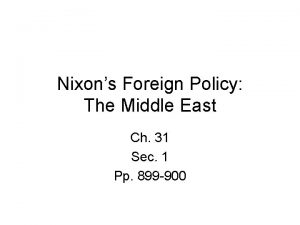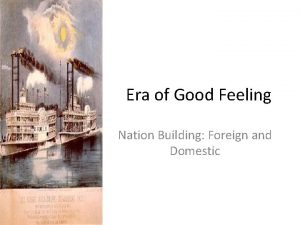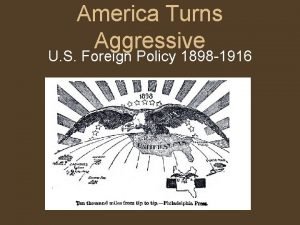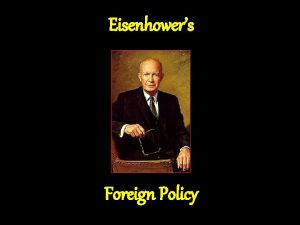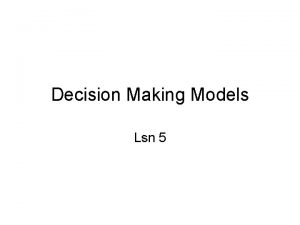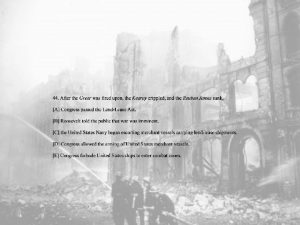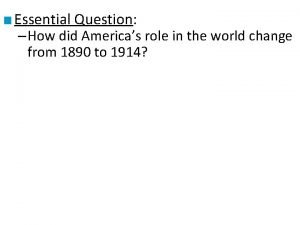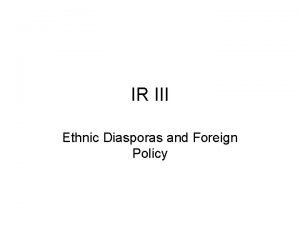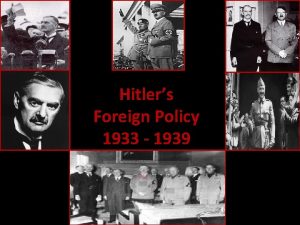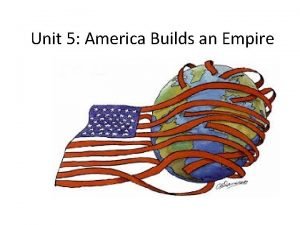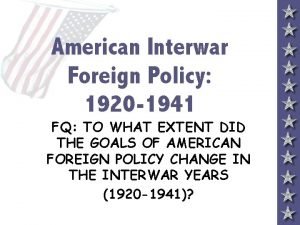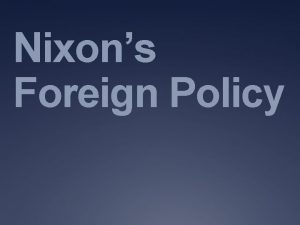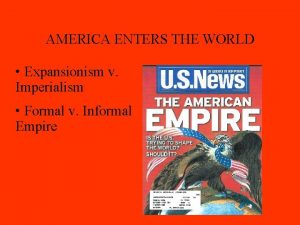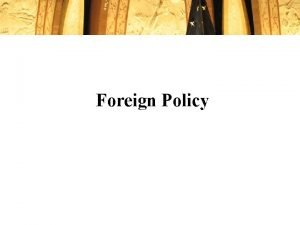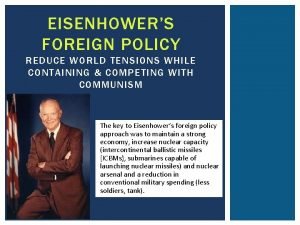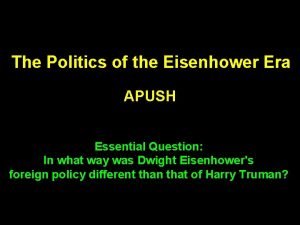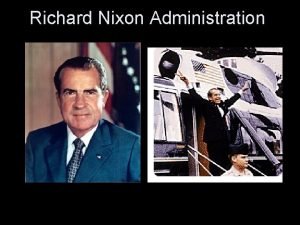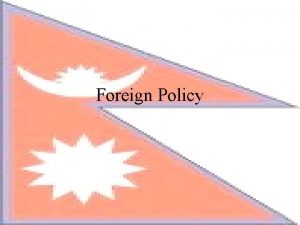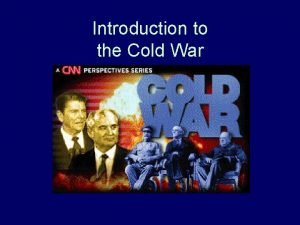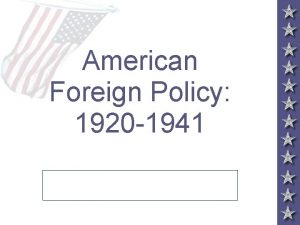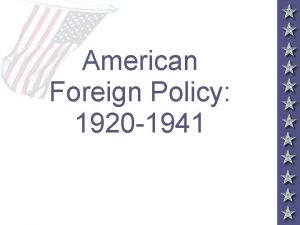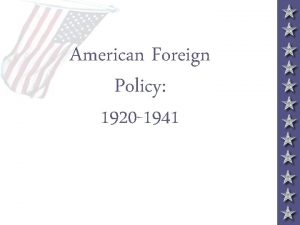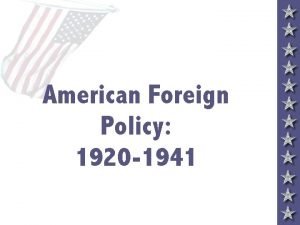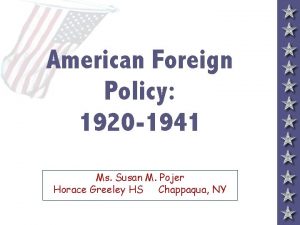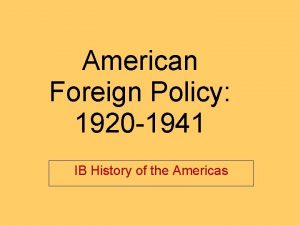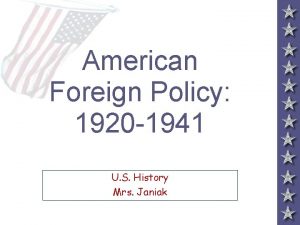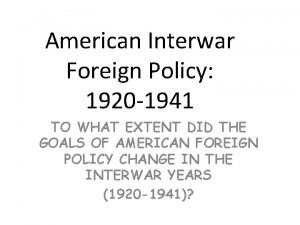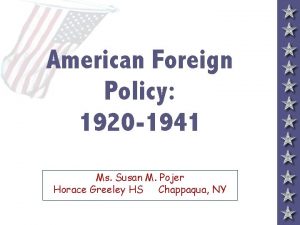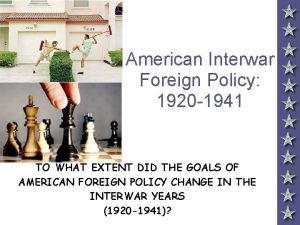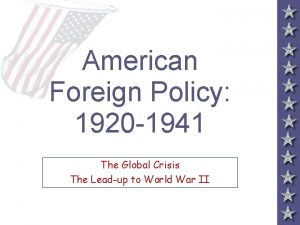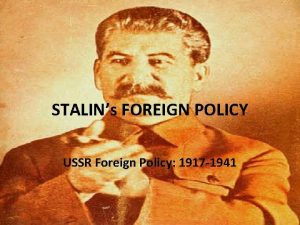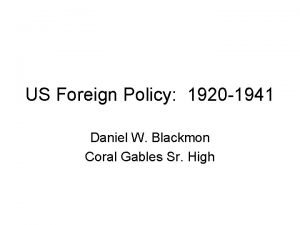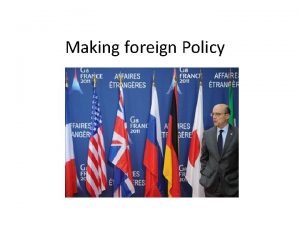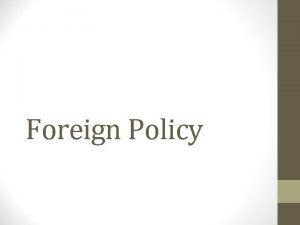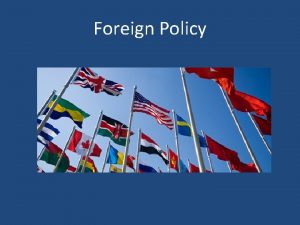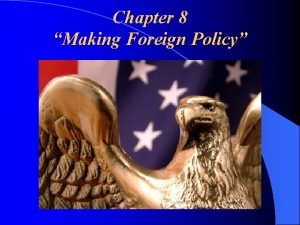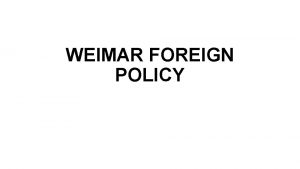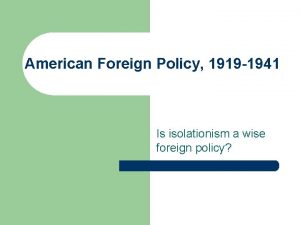American Foreign Policy 1920 1941 Foreign Policy Tensions

































- Slides: 33

American Foreign Policy: 1920 -1941

Foreign Policy Tensions Interventionism Disarmament • Collective security • Isolationism • “Wilsonianism” • Nativists • Business interests • Anti-war movement • Conservative Republicans

American Isolationism § Isolationists, like Senator Lodge, refused to allow the U. S. to sign the Versailles Treaty. § Thought the U. S. should stay out of “foreign wars” § July, 1921 Congress passed a resolution declaring WW I officially over! Sen. Henry Cabot Lodge, Sr. [R-MA]

Washington Disarmament Conference (1921 -1922) § Long-standing Anglo-Japanese alliance (1902) obligated Britain to aid Japan in the event of a Japanese war with the United States. § Goals naval disarmament and balancing power in the Pacific

Five-Power Treaty (1922) § The new battleship ratio: US 5 Britain 5 Japan 3 France 1. 67 Italy 1. 67 § Japan got a guarantee that the U. S. and Britain would stop Far East fortification/defense buildup [including the Philippines]. § Loopholes: § no restrictions on small warships § U. S. gets more because it has 2 oceans to protect

European Debts to the U. S.

Hyper-Inflation in Germany: 1923

The Dawes Plan (1924)

Young Plan (1930) § For three generations, you’ll have to slave away! § $26, 350, 000 to be paid over a period of 58½ years. § By 1931, Hoover declared a debt moratorium-canceling the debt.

Locarno Pact (1925) § Guaranteed the common boundaries of Belgium, France, and Germany as specified in the Treaty of Versailles of 1919. § Germany signed treaties with Poland Czechoslovakia, agreeing to change the eastern borders of Germany by arbitration only

Clark Memorandum (1928) § Clark pledged that the U. S. would not intervene in Latin American affairs in order to protect US property rights. § This was a complete Secretary of State J. Reuben Clark rebuke of the Roosevelt Corollary to the Monroe Doctrine!

Kellogg-Briand Pact (1928) § 15 nations dedicated to outlawing aggression and war as tools of foreign policy. § 62 nations signed. § Problems no means of actual enforcement and gave Americans a false sense of security.

Japanese Attack Manchuria (1931) § League of Nations condemned the action. § Japan leaves the League. § Hoover wanted no part in an American military action in the Far East.

Hoover-Stimpson Doctrine (1932) § U. S. would not recognize any territorial acquisitions that were achieved by force. § Japan was infuriated because the U. S. had conquered new territories a few decades earlier. § Japan bombed Shanghai in 1932 massive casualties, and considered an act of aggression.

FDR’s “Good Neighbor” Policy § Important to have all nations in the Western Hemisphere allied § FDR “The good neighbor respects himself and the rights of others. ” § Policy of non- intervention and cooperation.

FDR Recognizes the Soviet Union (late 1933) § FDR felt that recognizing Moscow might bolster the U. S. against Japanese imperialism (defense). § Thought trade with the U. S. S. R. would help the U. S. economy during the Depression (economics).

§ The Nye Committee Hearings (1934 -1936) The Nye Committees investigated allegations that the U. S. entered WW I to make big profits § Targeted: § Munitions owners § Bankers who wanted to protect loans and return investment § Claimed that Wilson had provoked Germany by sailing in to warring nations’ waters. § Resulted in Congress passing several Neutrality Acts. Senator Gerald P. Nye [R-ND]

FDR’s “I hate war” Speech (1936)

Neutrality Acts: 1935, 1936, 1937 § FDR proclaimed that during a foreign war, the U. S. would: § § § Prohibit sales of arms to belligerent nations. Prohibit loans and credits to belligerent nations. Forbid Americans to travel on vessels of nations-atwar [in contrast to WW I]. § Non-military goods must be purchased on a “cash-and- carry” basis pay when goods are picked up, no credit or loans § Banned involvement in the Spanish Civil War. § Effects: § Executive Authority limited. § America failed to mobilize.

American Neutrality

The Panay Incident (1937) December 12, 1937 § Japan bombed USS Panay gunboat & three Standard Oil tankers on the Yangtze River, an international waterway. § Japan was testing US resolve! § Japan apologized, paid US an indemnity, and promised no further attacks--most Americans satisfied with apology § Results Japanese interpreted US tone as a license for further aggression against US interests.

Spanish Civil War (1936 -1939) The American “Lincoln Brigade”

The Rise of Fascism § 1935 § Hitler denounced the § § Austrian Anschluss. Versailles Treaty and the League of Nations [rearming!] § Rome-Berlin Tokyo Pact [AXIS] § Munich Agreement § Mussolini attacks Ethiopia. § 1936: § German troops sent into APPEASEMENT! § 1939: § German troops march into the rest of Czechoslovakia. the Rhineland. § Hitler-Stalin Non-Aggression § Fascist forces sent to fight with Franco in Spain. 1938: Pact. § September 1, 1939: § German troops march in Poland blitzkrieg WW II begins!!!

1939 Neutrality Act § In response to Germany’s invasion of Poland. § FDR persuaded Congress to allow limited aid to European countries § Americans could sell weapons on a “cash-and-carry” basis. § FDR authorized to proclaim danger zones for American ships. § Results of the 1939 Neutrality Act: § Aggressors could not send ships to buy American munitions. § The U. S. economy improved as European demands for war goods helped bring the country out of the 1937 -38 recession. § America becomes the “Arsenal of Democracy. ”

“America First” Committee Charles Lindbergh

“Lend-Lease” Act (1941) Great Britain. . . $31 billion Soviet Union. . . . $11 billion France. . . . . $ 3 billion China. . . . . $1. 5 billion Other European. . . . $500 million South America. . . . . $400 million The amount totaled: $48, 601, 365, 000

Pearl Harbor

Admiral Isoroku Yamamoto

Pearl Harbor from the Cockpit of a Japanese Plane

Pearl Harbor – Dec. 7, 1941 A date which will live in infamy!

F. D. R. Signs the War Declaration

U. S. S. Arizona, Pearl Harbor

Pearl Harbor Memorial 2, 887 Americans Dead!
 Unit 4 lesson 10 american foreign policy
Unit 4 lesson 10 american foreign policy Lesson 5: american foreign policy
Lesson 5: american foreign policy American way of life 1920
American way of life 1920 Tensions mutations et crispations de la société d'ordres
Tensions mutations et crispations de la société d'ordres Who made it
Who made it So here you are too foreign for home
So here you are too foreign for home Nixons foreign policy
Nixons foreign policy Whats the era of good feelings
Whats the era of good feelings Henry viii foreign policy 1509-1529
Henry viii foreign policy 1509-1529 President taft’s foreign policy emphasized
President taft’s foreign policy emphasized Truman foreign policy vs eisenhower
Truman foreign policy vs eisenhower Actors in foreign policy
Actors in foreign policy Chapter 14 section 1 the search for spices
Chapter 14 section 1 the search for spices Foreign policy shift
Foreign policy shift Foreign policy of louis philippe
Foreign policy of louis philippe Foreign policy imperialism
Foreign policy imperialism Actors in foreign policy
Actors in foreign policy Hitlers foreign policy
Hitlers foreign policy Foreign policy
Foreign policy Interwar foreign policy
Interwar foreign policy Manchuria apush
Manchuria apush Foreign policy
Foreign policy Whats vietnamization
Whats vietnamization What was thomas jefferson foreign policy
What was thomas jefferson foreign policy Foreign policy imperialism
Foreign policy imperialism Definition of foreign policy by scholars
Definition of foreign policy by scholars Eisenhowers foreign policy
Eisenhowers foreign policy Eisenhower doctrine apush
Eisenhower doctrine apush Hitler's foreign policy timeline
Hitler's foreign policy timeline Foreign policy antonym
Foreign policy antonym Nixons foreign policy
Nixons foreign policy What is foreign policy analysis
What is foreign policy analysis Conclusion of foreign policy
Conclusion of foreign policy Andrew johnson foreign policy
Andrew johnson foreign policy
